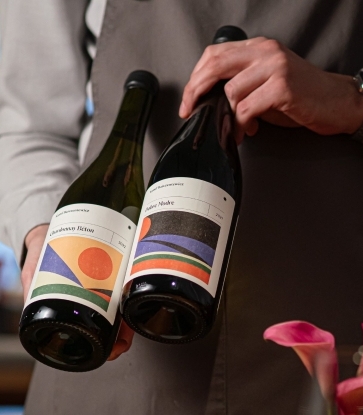A beer, margarita or michelada (a beer cocktail with lime juice, hot sauce, Worcestershire sauce and spices) is the obvious go-to beverage for Mexican food, but they can completely undercut the flavors of a delicate ceviche or overpower a simple tostada or tamale.
"A new perception of pairing wine with Mexican cuisine IS beginning to take shape. Like with any other type of pairing, it requires an understanding of the elements at play and a willingness to present it to diners," says Noah Small, beverage director at the Empellón family of restaurants in New York City.
We asked leading beverage directors and somms from some of the country's top Mexican restaurants on how exactly how to pair wine with your plato favorito.
Ceviche and Other Raw Seafood Dishes
These dishes have a broad range of pairing options, but naturally lend themselves to white or Rosé wines. Small goes for Albariño. He particularly likes the Benito Santos Pago de Xoan for its acidity and freshness. "It's essentially grown in soil composed of ground-up seashells," he says.Mathieu Giraud, general manager at Broken Spanish in Los Angeles, suggests a bright Côtes de Provence Rosé that will match—but not overpower—the raw seafood's delicate profile (particularly white fish or shrimp).
Don't sleep on Greek whites or Rosés either, advises Small. "I love Greek whites and Rosé for their bright acidity. Looking at much of Greek cooking tradition, we see plenty of fish preparations dressed with citrus. There's actually a nice parallel there [to Mexican cuisine]," says Small.

Cooked Seafood
Dry white wines bring acidity to cooked fish and just enough fruit so as to not overpower the protein. Small often chooses Txakoli from the Basque region, but if there's none to be had, Grüner Veltliner also does the job.Another good choice: Chablis from Château de Béru. Yana Volfson, beverage director of Cosme and Atla in New York City, loves it for its elegant texture and underbelly of smokiness to drink with softer and fleshier fish.
With seafood that has meatier texture like octopus, Volfson recommends a dry white like Côtes Catalanes Blanc or a blend of Grenache Gris and Macabeu from Domaine Matassa. "Its salty and savory form pairs well with the [charred flavor] of [grilled] seafood," says Volfson.
![At Empellón, "[The short rib confit with picadillo garnish] pairs beautifully with the Tertre Roteboeuf Saint-Émilion Grand Cru," says Small. (Photo by Evan Sung.)](https://d3h1lg3ksw6i6b.cloudfront.net/media/image/2018/07/24/24ca01de85ec4023809735166b660d39_Empellon_Short-Rib-Confit_Credit_Evan-Sung-INLINE.jpg)
Red Meats and Poultry
For heavier proteins like carne asada or carnitas, don't shy away from Bordeaux. Small is careful to select something with soft tannins, like Château le Puy.At Empellón, "[The short rib confit with picadillo garnish] pairs beautifully with the Tertre Roteboeuf Saint-Émilion Grand Cru," says Small.
For duck or pollo, dry(er) whites are the way to go. Giraud pairs Broken Spanish's spicy and smoky duck meat albondigas (meatballs) with a dry white Scheurebe from Weingut Pfeffingen in Germany.

Tacos and Burritos
It all depends. It's best to take lead from the dominant protein in the dish.Fish? Follow pairings for cooked or grilled seafood. For a fish taco, Small says that whites from Cinque Terre like a Bisson Marea are especially good.
A heavier red meat like al pastor or carnitas? In this case Small says, "German Riesling all day."
But let's say we were eating a steak, rice and beans burrito—Rioja Reserva is the way to go according to Small.
Elote and Corn-Based Dishes
When corn or maíz is the dominant ingredient of a dish, like in tamales or pozole, take into consideration the filling (if any), as well."I like Malvasia from Croatia with pozole. In the case of tamales, it's very much dependent what else is in the tamal itself. We offer a sticky rice 'tamal' with red chile duck at Empellón that I love with Pinot Noir like Antiquum Farm from Willamette or even Gamay," says Small.
Volfson agrees. "Given the diversity of corn in the culture of Mexican cuisine, I think there are different wines to experience with the different colors of corn we cook with."
Bottom line: Small recommends that diners look for soft tannins when choosing red wines and vibrant acidity in whites to pair with Mexican cuisine. And don't shy away from bubbles.
And while proteins usually dictate pairings, don't forget about the sauce.
"The depth and range of Mexican sauce work is staggering and probably underappreciated, as such, sauces can often dictate the most appropriate pairing," says Small. If eating something like a complex mole, ask your sommelier or beverage director for a recommendation given the multitude and layers of flavors and spices at hand.
With the changing perception of Mexican food, what we drink with it is changing, too.
"I think people associate Mexican cuisine with beer because it is refreshing and a good palate cleanser. Also, it is cheaper than wine, which is another association that is being made about Mexican food," says Giraud.
But as the cuisine is presented more and more in a fine dining format, mentalities are evolving. "As the world learns more about Mexican gastronomy, especially in cities like New York, we will start to see trends shift," says Volfson.




















